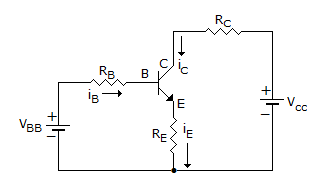Electronics and Communication Engineering - Analog Electronics - Discussion
Discussion Forum : Analog Electronics - Section 1 (Q.No. 20)
20.
The transistor of following figure in Si diode with a base current of 40 μA and ICBO = 0, if VBB = 6V, RE = 2 kΩ and β = 90, IBQ = 20 μA then RB =


Answer: Option
Explanation:
 .
.
Discussion:
13 comments Page 1 of 2.
Srujana said:
9 years ago
Ibq is base current at operating point taken as 0.7, this 0.7 is the barrier potential voltage at base.
(2)
Atul said:
1 decade ago
What about Re?
Balu said:
1 decade ago
Why we not consider loop for i/p side?
Arnab Bhattacharya said:
10 years ago
Ic = βIB + (β+1) ICBO => Ic = βIb [Since, ICBO = 0; given].
SO, Ic = 90*20 uA = 1.8 mA.
Voltage drop across RE = IE*RE = (IC+IB)*RE = IC*RE (approx) = 1.8*2 = 3.6 V.
Now, VBB = RB*IB + VBE + voltage across RE.
6 = RB*20 uA + 0.7 + 3.6 = RB*20 uA + 4.3.
RB*20 uA = 1.7 => RB = 1.7/20 uA = 85 KOhm.
So, my result is none of the above options. Please mention if I am missing something. Thanks in advance.
SO, Ic = 90*20 uA = 1.8 mA.
Voltage drop across RE = IE*RE = (IC+IB)*RE = IC*RE (approx) = 1.8*2 = 3.6 V.
Now, VBB = RB*IB + VBE + voltage across RE.
6 = RB*20 uA + 0.7 + 3.6 = RB*20 uA + 4.3.
RB*20 uA = 1.7 => RB = 1.7/20 uA = 85 KOhm.
So, my result is none of the above options. Please mention if I am missing something. Thanks in advance.
Nitesh said:
9 years ago
I also agree with Arnab.
Can anyone please clarify, if we are wrong somewhere.
Can anyone please clarify, if we are wrong somewhere.
Raghu said:
9 years ago
What is 40 μA? Why it is given here?
Bharadwaz said:
9 years ago
Yeah! I have the same doubt. Why shouldn't we consider input loop to find Rb?
I don't think the procedure to find the Rb changes, if the operating point conditions are giving?
If I am wrong, please correct me.
I don't think the procedure to find the Rb changes, if the operating point conditions are giving?
If I am wrong, please correct me.
RONI said:
9 years ago
What is the difference between IB AND IBQ?
Please anyone tell me.
Please anyone tell me.
Pramit said:
8 years ago
The given solution is incorrect. We have to consider the drop across the emitter resistor. And we have to include it in the input loop equation.
Vijay said:
8 years ago
Hi, I'm getting an answer between 100 and 150 whatever the answer is. The given answer is wrong we should consider the emitter resistor.
Please, anyone, explain me.
Please, anyone, explain me.
Post your comments here:
Quick links
Quantitative Aptitude
Verbal (English)
Reasoning
Programming
Interview
Placement Papers